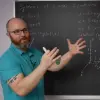

NARROW DISPLAY WARNING
You are most likely using a tablet or mobile device in portrait orientation. This website is best viewed using a typical computer screen with the browser window maximized.
Viewing this website in portrait orientation can cause problems with equations being longer than the screen width (you can scroll to the right), images being poorly sized, and the font size of maths text being much smaller than regular text. If your only option is a tablet or mobile device, your viewing experience will be better if you view this website in landscape orientation. You might need to refresh the page to fix any problems after rotating.
These theorems are applicable to initial value problems
\begin{equation} y' = f(x,y) \qquad y(x_{0}) = y_{0} \end{equation}where the point $(x_{0},y_{0})$ is contained in an open rectangle $a < x < b$, $c < y < d$ called $R$.
The meaning of $A \Rightarrow B$, which is read as "A implies B" or "if A then B", has a specific meaning in mathematics that doesn't quite match up with normal conversation.
The short definition is when $A$ is a true statement, $B$ is a true statement. When $A$ is a false statement, $B$ could be either true or false.
A more concrete example is statement $A$ is "I ran over your laptop with my car." and statement $B$ is "Your laptop won't turn on." where your laptop is a normal laptop.
• If statement $A$ is true, then statement $B$ is guaranteed to be true. Normal laptops do not turn on after being crushed under the wheel of a car.
• If statement $A$ is false, then statement $B$ could be true or false. Just because I didn't run over your laptop with my car doesn't mean your laptop won't turn on. There are many reasons your laptop won't turn on, like the battery is dead, you spilled water on it, and I ran over your laptop with my car.
For $A \Rightarrow B$, when $A$ is a false statement, you know absolutely nothing about statement $B$.
$f(x,y)$ is continuous on the open rectangle $R \qquad \Rightarrow \qquad$ the initial value problem has at least one solution on some open subinterval of $(a,b)$ that contains $x_{0}$.
$f(x,y)$ and $\dfrac{\partial f}{\partial y}$ are continuous on the open rectangle $R \qquad \Rightarrow \qquad$ the initial value problem has exactly one solution on some open subinterval of $(a,b)$ that contains $x_{0}$.
Determine when an initial value problem would exist or is unique based on the theorems. Use the Direction Field Plotter by Ariel Barton to plot some integral curves. Solve the ODE. Investigate what happens when either $f(x,y)$ or $\dfrac{\partial f}{\partial y}$ are not continuous, if ever.
\begin{equation} y' = 2xy \end{equation}Determine when an initial value problem would exist or is unique based on the theorems. Use the Direction Field Plotter by Ariel Barton to plot some integral curves. Solve the ODE and determine why the left half of the parabola doesn't solve the ODE. Investigate what happens when either $f(x,y)$ or $\dfrac{\partial f}{\partial y}$ are not continuous, if ever.
\begin{equation} y' = 2\sqrt{y} \end{equation}Determine when an initial value problem would exist or is unique based on the theorems. Use the Direction Field Plotter by Ariel Barton to plot some integral curves. Solve the ODE. Investigate what happens when either $f(x,y)$ or $\dfrac{\partial f}{\partial y}$ are not continuous, if ever.
\begin{equation} xy' + y = 3x^{2} \end{equation}Determine when an initial value problem would exist or is unique based on the theorems, if ever. Use the Direction Field Plotter by Ariel Barton to plot some integral curves. Solve the ODE. Investigate what happens when either $f(x,y)$ or $\dfrac{\partial f}{\partial y}$ are not continuous, if ever.
\begin{equation} y' = \frac{y+1}{x+1} \end{equation}Determine when an initial value problem would exist or is unique based on the theorems. Use the Direction Field Plotter by Ariel Barton to plot some integral curves. Do NOT solve the ODE. Investigate what happens when either $f(x,y)$ or $\dfrac{\partial f}{\partial y}$ are not continuous, if ever.
\begin{equation} y' = \frac{1}{1-x^{2}-y^{2}} \end{equation}Determine when an initial value problem would exist or is unique based on the theorems. Use the Direction Field Plotter by Ariel Barton to plot some integral curves. Investigate what happens when either $f(x,y)$ or $\dfrac{\partial f}{\partial y}$ are not continuous, if ever. Do NOT attempt to solve the ODE in general, but set $y = mx$ and solve for the approximate value of $m$ that satisfies the ODE.
\begin{equation} y' = \frac{x^{2}-y^{2}}{x^{2}+y^{2}} \end{equation}